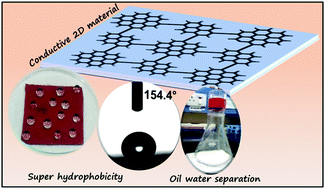Conducting and superhydrophobic hybrid 2D material from coronene and pyrene†
Abstract
Graphdiyne, a recent addition to the family of 2D covalent organic nanosheet structures, is known for its structural stability and potential applications in catalysis, sensors, electronics and optoelectronics. The design and synthesis of graphdiyne analogues with well-defined structures and useful applications remains a challenging task for materials chemists. Herein, we report a novel, well-defined 2D nanosheet from a coronene–pyrene hybrid 2D material (COPY), with extended π conjugation through acetylenic linkages. The bulk synthesis of the polymeric network has been realized via Sonogashira coupling of 1,4,7,10-tetrabromocoronene and 1,3,6,8-tetraethynylpyrene. The nanosheet is characterized using HR-SEM, TEM, AFM, FT-IR, Raman, XRD and XPS techniques. Electrostatic potential mapping of COPY reveals complete π electron delocalization over the 2D framework with a relatively high electro-negative potential at the acetylenic linkages. Computational study reveals the high planarity of the structure as a result of Cs point group symmetry and the material has a tunable bandgap with respect to the number of coronene and pyrene rings. Extended conjugation in the material accounts for the significant electrical conductivity (1.16 × 10−3 S m−1) that is one order of magnitude higher than that of graphdiyne and comparable to the previously reported pyrediyne (a graphdiyne analogue). The large surface area and porous nature of the material were utilized for oil–water separation by incorporating melamine sponge and cotton fabric. The COPY-incorporated cotton fabric exhibited an oil–water separation efficiency of 95.5%. More importantly, the COPY in the melamine sponge exhibited superhydrophobicity with a contact angle of 154.4°. The oil–water separation efficiency, significant electrical conductivity and superhydrophobicity of the material suggest that COPY can be a valuable candidate in the field of water repellency, anti-corrosion and biosensing.



 Please wait while we load your content...
Please wait while we load your content...